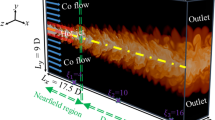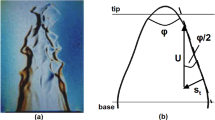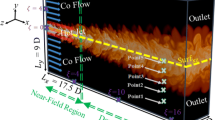Abstract
Propellant injection and turbulent combustion in high-pressure engines is often dominated by real-gas effects. However, previous studies suggested that the departure of the fluid properties from an ideal gas behavior has only a limited effect on the laminar flame structure. This is due to the fact that chemical reactions take place in the flame zone where the temperature is sufficiently high and molecular interactions are negligible, i.e., the ideal gas assumption is valid. On the other hand, various experimental and numerical studies of injection processes at high-pressure conditions demonstrated that real-gas effects can have a strong impact on the turbulent flow. Mixing is influenced by the rapid change of fluid properties. In this work, we exploit the gap in the fidelity of the thermodynamics model needed to describe the laminar flame structure and that needed to describe the turbulent flow field. We then propose a new real-gas flamelet model with increased numerical performance. The computational cost of the new formulation is not significantly higher than that of an ideal gas simulation. The performance of the method is analyzed and the error that is introduced by our assumptions is assessed by comparison to more complete modeling. Finally, the method is used to simulate a turbulent jet flame emanating from a coaxial injector at supercritical pressure and cryogenic oxidizer temperature. The results are compared with experimental OH∗ images giving evidence of the suitability of the present method.

















Similar content being viewed by others
Notes
OpenFOAM: www.openfoam.org
GRI-mechanism: http://www.me.berkeley.edu/gri_mech/
References
Mayer, W., Schik, A., Vielle, B., Chaveau, C., Gökalp, I., Talley, D.: Atomization and breakup of cryogenic propellants under high pressure subcritical and supercritical conditions. J. Propuls. Power 14(5), 835 (1998)
Mayer, W., Tamura, H.: Propellant injection in a liquid oxygen/gaseous hydrogen rocket engine. J. Propuls. Power 12(6), 1137 (1996)
Simeoni, G., Bryk, T., Gorelli, F., Krisch, M., Ruocco, G., Santoro, M., Scopigno, T.: The Widom line as the crossover between liquid-like and gas-like behaviour in supercritical fluids. Nat. Phys. 6, 503 (2010)
Oschwald, M., Smith, J.J., Branam, R., Hussong, J., Schik, A., Chehroudi, B., Talley, D.: Injection of fluids into supercritical environments. Combust. Sci. Technol. 178(1-3), 49 (2006)
Banuti, D.: Crossing the Widom-line - Supercritical pseudo-boiling. J. Supercrit. Fluids 98, 12 (2015)
Chehroudi, B.: Recent experimental efforts on high-pressure supercritical injection for liquid rockets and their implications. Int. J. Aerospace Eng., 2012 (2012)
Oefelein, J., Yang, V.: Modeling high-pressure mixing and combustion processes in liquid rocket engines. J. Propuls. Power 14(5), 843 (1998)
Zong, N., Meng, H., Hsieh, S.Y., Yang, V.: A numerical study of cryogenic fluid injection and mixing under supercritical conditions. Phys. Fluids (1994-present) 16(12), 4248 (2004)
Oefelein, J.: Thermophysical characteristics of shear-coaxial LOX-H2 flames at supercritical pressure. Proc. Combust. Inst. 30(2), 2929 (2005)
Masquelet, M., Guezennec, N., Menon, S.: Numerical studies of mixing and flame-turbulence interactions in shear coaxial injector flows under trans-critical conditions. In: 50th AIAA Aerospace Sciences Meeting including the New Horizons Forum and Aerospace Exposition: AIAA Paper 2012-1269 (2012)
Guezennec, N., Masquelet, M., Menon, S.: Large Eddy Simulation of flame-turbulence interactions in a LOX-CH4 shear coaxial injector. In: 50th AIAA Aerospace Sciences Meeting including the New Horizons Forum and Aerospace Exposition: AIAA Paper 2012-1267 (2012)
Schmitt, T., Méry, Y., Boileau, M., Candel, S.: Large-Eddy Simulation of oxygen/methane flames under transcritical conditions. Proc. Combust. Inst. 33(1), 1383 (2011)
Hakim, L., Ruiz, A., Schmitt, T., Boileau, M., Staffelbach, G., Cuenot, B., Candel, S.: Large eddy simulations of multiple transcritical coaxial flames submitted to a high-frequency transverse acoustic modulation. Proc. Combust. Inst. 35(2), 1461 (2014)
Urbano, A., Selle, L., Staffelbach, G., Cuenot, B., Schmitt, T., Ducruix, S., Candel, S.: Exploration of combustion instability triggering using Large Eddy Simulation of a multiple injector liquid rocket engine. Combustion and Flame 169, 129 (2016)
Hickey, J.P., Ihme, M.: Large Eddy Simulation of supercritical mixing and combustion for rocket applications. In: 52Nd Aerospace Sciences Meeting: AIAA Paper 2014-0138 (2014)
Petit, X., Ribert, G., Domingo, P.: Framework for real-gas compressible reacting flows with tabulated thermochemistry. J. Supercrit. Fluids 101, 1 (2015)
Müller, H., Pfitzner, M.: A flamelet model for transcritical LOx/GCH4 flame. J. Phys.: Conf. Ser. 821, 012010 (2017)
Masi, E., Bellan, J., Harstad, K., Okong’o, N.: Multi-species turbulent mixing under supercritical-presure conditions: modelling direct numerical simulation and analysis revealing species spinodal decomposition. J. Fluid Mech. 721, 578 (2013)
Bellan, J.: Direct numerical simulation of a high-pressure turbulent reacting temporal mixing layer. Combustion and Flame 176, 245 (2017)
Peters, N.: Turbulent Combustion. Cambridge University Press, Cambridge (2000)
Stoer, J., Bulirsch, R.: Introduction to Numerical Analysis, vol. 12. Springer Science & Business Media, Berlin (2013)
Vreman, A.W.: An eddy-viscosity subgrid-scale model for turbulent shear flow: algebraic theory and applications. Phys. Fluids (1994 - present) 16(10), 3670 (2004)
Kemenov, K., Wang, H., Pope, S.: Modelling effects of subgrid-scale mixture fraction variance in LES of a piloted diffusion flame. Combust. Theory Model. 16(4), 611 (2012)
Domingo, P., Vervisch, L., Veynante, D.: Large-eddy simulation of a lifted methane jet flame in a vitiated coflow. Combustion and Flame 152, 415 (2008)
Issa, R.I.: Solution of the implicitly discretised reacting flow equations by operator-splitting. J. Comput. Phys. 93(2), 388 (1991)
Jarczyk, M., Pfitzner, M.: Large Eddy Simulation of supercritical nitrogen jets. In: 50th AIAA Aerospace Sciences Meeting including the New Horizons Forum and Aerospace Exposition: AIAA Paper 2012-1270 (2012)
Cook, A., Cabot, W.: Hyperviscosity for shock-turbulence interactions. J. Comput. Phys. 203(3), 2133 (2005)
Terashima, H., Kawai, S., Yamanishi, N.: High-resolution numerical method for supercritical flows with large density variations. AIAA J. 49(12), 2658 (2011)
Chung, T.H., Ajlan, M., Lee, L.L., Starling, K.E.: Generalized multiparameter correlation for nonpolar and polar fluid transport properties. Ind. Eng. Chem. Res. 27 (4), 671 (1988)
Kim, T., Kim, Y., Kim, S.K.: Effects of pressure and inlet temperature on coaxial gaseous methane/liquid oxygen turbulent jet flame under transcritical conditions. J. Supercrit. Fluids 81, 164 (2013)
Peng, D.Y., Robinson, D.P.B.: A new two-constant equation of state. Ind. Eng. Chem. Fundamentals 15(1), 59 (1976)
Matheis, J., Müller, H., Lenz, C., Pfitzner, M., Hickel, S.: Volume translation methods for real-gas computational fluid dynamics simulations. J. Supercrit. Fluids 107, 422 (2016)
Abudour, A.M., Mohammad, S.A., Robinson, R.L., Gasem, K.A.M.: Volume-translated Peng-Robinson equation of state for liquid densities of diverse binary mixtures. Fluid Phase Equilib. 349, 37 (2013)
Poling, B.E., Prausnitz, J.M., O’Connell, J.P.: The Properties of Gases and Liquids. Mc Graw Hill, New York City (2001)
Goos, E., Burcat, A., Ruscic, B.: Extended third millennium ideal gas and condensed phase thermochemical database for combustion with updates from active thermochemical tables. http://burcat.technion.ac.il/dir (2009)
Singla, G., Scouflaire, P., Rolon, C., Candel, S.: Transcritical oxygen/transcritical or supercritical methane combustion. Proc. Combust. Inst. 30(2), 2921 (2005)
Ribert, G., Zong, N., Yang, V., Pons, L., Darabiha, N., Candel, S.: Counterflow diffusion flames of general fluids: Oxygen/hydrogen mixtures. Combustion and Flame 154(3), 319 (2008)
Pons, L., Darabiha, N., Candel, S., Ribert, G., Yang, V.: Mass transfer and combustion in transcritical non-premixed counterflows. Combust. Theor. Model. 13(1), 57 (2009)
Lacaze, G., Oefelein, J.C.: A non-premixed combustion model based on flame structure analysis at supercritical pressures. Combustion and Flame 159(6), 2087 (2012)
Giovangigli, V., Matuszewski, L., Dupoirieux, F.: Detailed modeling of planar transcritical H2-O2-N2 flames. Combust. Theor. Model. 15(2), 141 (2011)
Giovangigli, V., Matuszewski, L.: Numerical simulation of transcritical strained laminar flames. Combustion and Flame 159, 2829 (2012)
Ribert, G., Petit, X., Domingo, P.: High-pressure methane-oxygen flames. Analysis of sub-grid scale contributions in filtered equations of state. J Supercrit. Fluids 121, 78 (2017)
Juanós, A.J., Sirignano, W.A.: Pressure effects on real-gas laminar counterflow. Combustion and Flame 181, 54 (2017)
Ivancic, B., Mayer, W.: Time- and length scales of combustion in liquid rocket thrust chambers. J. Propuls. Power 18(2), 247 (2002)
Ihme, M., Pitsch, H.: Modeling of radiation and nitric oxide formation in turbulent nonpremixed flames using a flamelet/progress variable formulation. Phys. Fluids 20(5), 1 (2008)
Prüfert, U., Hunger, F., Hasse, C.: The analysis of chemical time scales in a partial oxidation flame. Combustion and Flame 161(2), 416 (2014)
Goodwin, D., Moffat, H.K., Speth, R.L. http://www.cantera.org (1993)
Habiballah, M., Orain, M., Grisch, F., Vingert, L., Gicquel, P.: Experimental studies of high-pressure cryogenic flames on the Mascotte facility. Combust. Sci. Technol. 178(1-3), 101 (2006)
Candel, S., Herding, G., Snyder, R., Scouflaire, P., Rolon, C., Vingert, L., Habiballah, M., Grisch, F., Palat, M., Bouchardy, P., Stepowski, D., Cessou, A., Colin, P., Péalat, M., Bouchardy, P., Stepowski, D., Cessou, A., Colin, P.: Experimental investigation of shear coaxial cryogenic jet flames. J Propuls. Power 14(5), 826 (1998)
Weise, S., Hasse, C.: Reducing the memory footprint in large eddy simulations of reactive flows. Parallel Comput. 49, 50 (2015)
Pope, S.: Ten questions concerning the large-eddy simulation of turbulent flows. New J. Phys. 6(1), 35–59 (2004)
Fiala, T., Sattelmayer, T.: Assessment of Existing and New Modeling Strategies for the Simulation of OH* Radiation in High-Temperature Flames. CEAS Space J 8 (1), 47 (2016)
Cutrone, L., De Palma, P., Pascazio, G., Napolitano, M.: A RANS flamelet-progress-variable method for computing reacting flows of real-gas mixtures. Comput. Fluids 39, 485 (2010)
Acknowledgements
We thank Christian Hasse and his team from the TU Bergakademie Freiberg for the fruitful cooperation and for sharing their flameletConfig libraries for memory-efficient flamelet tabulation. Financial support has been provided by the German Research Foundation (Deutsche Forschungsgemeinschaft – DFG) in the framework of the Sonderforschungsbereich Transregio 40. The authors gratefully acknowledge the Gauss Center for Supercomputing e.V. (http://www.gauss-center.eu) for funding this project by providing computing time on the GCS Supercomputer SuperMUC at Leibniz Supercomputing Center (LRZ, http://www.lrz.de).
Author information
Authors and Affiliations
Corresponding author
Additional information
Publisher’s Note
Springer Nature remains neutral with regard to jurisdictional claims in published maps and institutional affiliations.
Appendices
Appendix A: Effects of Strain
Figure 18a shows the maximum temperature Tmax of the resulting flamelets over a range of scalar dissipation rates. The maximum temperature does not experience significant changes up to χst ≈ 2 ⋅ 104 1/s. A further increase of the scalar dissipation rate rate leads to a monotonic decrease of Tmax until extinction occurs at χext ≈ 7 ⋅ 105 1/s. Figure 18b demonstrates the effect of strain on the temperature profile. Comparing the flamelet solutions at χst = 1, 1 ⋅ 102, 1 ⋅ 104 and 1 ⋅ 105 1/s shows that higher strain rates lead to increasing temperatures in the diffusion dominated region of the flame on the fuel side.
Appendix B: Effects of Pressure
Two additional flamelet solutions at χst = 1000 1/s with varying pressure are evaluated to assess the influence of pressure variations on the flame structure in the turbulent flow. The pressure boundaries are chosen to be 50.1 bar and 61.7 bar which represents a deviation of approximately 10% to the operating pressure of 56.1 bar in both directions. These boundaries lie well above the pressure fluctuations observed in the LES results.
Figure 19 reveals that a deviation in this range has only a minor effect on the flame structure. The density at the oxygen boundary varies as \(\rho _{O_{2},50.5\text {bar}} = 1176.36~\text {kg/m}^{3}\) and \(\rho _{O_{2},61.7\text {bar}} = 1178.06~\text {kg/m}^{3}\) compared to the reference value \(\rho _{O_{2},56.1\text {bar}} = 1177.21~\text {kg/m}^{3}\). The differences for the temperature and species mass fraction profiles are also negligible. However, note that the insensitivity of the results observed in mixture fraction space can not directly be transferred to physical space. In particular, Ribert et al. [37] showed for high pressure LOx/H2 flames that the flame thickness decreases with \(\delta (x) \propto 1/\sqrt {p}\) and the species profiles shift toward the fuel side.
Rights and permissions
About this article
Cite this article
Zips, J., Müller, H. & Pfitzner, M. Efficient Thermo-Chemistry Tabulation for Non-Premixed Combustion at High-Pressure Conditions. Flow Turbulence Combust 101, 821–850 (2018). https://doi.org/10.1007/s10494-018-9932-4
Received:
Accepted:
Published:
Issue Date:
DOI: https://doi.org/10.1007/s10494-018-9932-4






